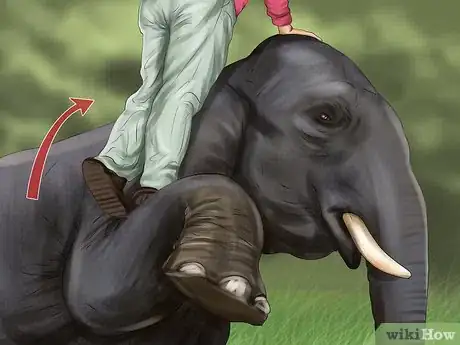This article was co-authored by wikiHow Staff. Our trained team of editors and researchers validate articles for accuracy and comprehensiveness. wikiHow's Content Management Team carefully monitors the work from our editorial staff to ensure that each article is backed by trusted research and meets our high quality standards.
This article has been viewed 31,502 times.
Learn more...
Despite many animal organizations suggesting that you should not ride elephants, it still a popular tourist activity in many countries, such as Thailand and Africa. However, many trainers practice inhumane training methods that hurt the elephant when it carries passengers. Choose to ride an elephant in a way that is safe for the both of you. If you decide that you do not want to ride an elephant, there are many other ways you can experience them up close and personal.
Steps
Mounting and Riding An Elephant
-
1Wear light weight clothing. Decide between shorts or pants. Shorts might keep you cooler, but make sure to wear longer shorts as they will ride up. Pants would help protect your legs from possible vegetation and bugs. You can always roll your pants up if it's too hot.
- You may also want to bring a hat, bug spray, and sunblock.
- Take a change of clothes with you. Some elephant trails cross or arrive at rivers in which the elephants might enter to play. Be prepared to possibly get wet.
- Leave anything you would care about breaking behind.
-
2Learn foot commands. When you ride an elephant, you use your feet to control the elephant's movement. Your instructor should teach you the commands before your ride. Be sure that you understand and practice the commands before you get on your elephant. Here are some basic commands:
- To walk forwards, press your toes behind the elephant's ears.
- To walk backwards, press backwards with your heels.
- To have the elephant lift its trunk, use your toes to push upwards.
- To have the elephant sit down, push downward with one of your heels.
- To have the elephant turn to the left, hold your left heel backwards and press forward with your right toes.
- To have the elephant turn right, hold your right heel backwards and press forward with your left toes.
Advertisement -
3Approach the elephant from the right side. Always approach the elephant from the side where it can see you. If you come at the elephant from the back or from the front, the elephant may not be able to see you. Many elephants are trained to attack anyone that approaches from the left so always approach from the elephant's right side.[1]
- Pay attention to the elephant's demeanor as you approach. Signs of a happy elephant include flapping ears and a swaying trunk and tail.
- The elephant may examine you with its trunk to smell you or see if you have some food.
- If the elephant is staring at you intently, holding their trunk in the mouth, or blowing the elephant may feel threatened or anxious. Do not approach the elephant if you notice any of these things.
-
4Mount the elephant. There are many different ways to mount an elephant. You can mount an elephant by using the front or hind legs, ears, trunk, or by stepping on the tusks. The instructor will have the elephant kneel so that you can mount. Grab the elephant's right ear and place your foot on its bent knee. Bend your knee and then swing your other leg over the elephant.
- Your instructor will give you directions before you mount and walk you through the process.
- Try to mount as quickly as possible. Your elephant may begin to stand up rather quickly.[2]
-
5Sit up straight. Sit as forward on the neck as possible and tuck your legs behind the elephant's ears. Keep your toes behind the elephant's ears so you can give instructions. Sit up straight but be flexible and move with the elephant. This helps to keep your balance.[3]
- Remember, elephants sway as they walk, so do not be too rigid.
- If you feel like you're losing your balance place your hands on the elephant's back or neck to steady yourself.
-
6Ride the elephant bareback. If you have the option, choose to ride the elephant bareback instead of using a chair. An elephant's neck is much stronger than its back. Riding on a chair puts more pressure on the elephant's back.
- Often times saddles are on put on incorrectly or tightened improperly which leads to chafing of the elephant's skin.
- Riding bareback also allows you to be closer and more intimate with the elephant.
-
7Dismount the elephant. You will dismount the elephant the same way that you mounted the elephant. Command the elephant to sit down. Hold on to the elephant's right ear, bend your knees and swing your left foot over the elephant's body. Place your leg on its bent knee as you step down.
- Make sure the elephant is in the sitting position before you begin to dismount.
- Remember to maintain your balance as the elephant kneels down.
Choosing an Elephant Camp
-
1Be allowed to ride bareback, by yourself. Riding bareback with only one person per elephant is in the best interest of the animal. Avoid places that allow more than one rider and that strap platforms to the backs of the elephants.[4] If you visit a place that has platforms, ask to ride bareback instead.
- Make sure the camp you choose has weight limits for riders.
- The rides should also be no more than 20 minutes.[5] Long rides are difficult for the elephant.
-
2Determine how the staff treat the elephants. Many different methods are used to control an elephant. Verbal and foot commands and positive reinforcement are healthy ways to control an elephant. If you notice that hooks, nails, fear, and punishment are used to control the animals, choose a different camp.[6]
- Fresh cuts and bloody wounds may be a sign that the elephant is being abused. Cuts are often covered in a purple antiseptic spray, a bandage, or a plastic bag.
- You can also check to see if there have been any complaints of abuse or mistreatment filed against the elephant camp.
- Visit the camp website and read reviews before you visit. If the site mentions any type of elephant show or elephant painting, choose a different camp.
-
3Examine the elephant's environment. Elephants are social animals and like to be with other elephants. Choose a camp that allows the elephants to socialize and not be isolated. The elephants should be allowed to roam freely and not be chained up.[7]
- If you notice the elephants are swaying in place or rocking, they are likely experiencing emotional distress.
- The elephants should also have regular access to food, water and mud.
Experiencing Elephants in Other Ways
-
1Understand the problem with riding elephants. Elephants are wild animals and must be controlled before humans can ride them. In order to control them, elephants are put through training that breaks their spirit and makes them more compliant. Elephants are often deprived of food and sleep and are physically abused to achieve this. Elephants in captivity also die younger than elephants that remain in the wild.[8]
- Asian elephants are an endangered species, and while responsible elephant tourism can help conserve these animals, elephant riding is not considered responsible tourism and does more harm than good.
- If you do choose to ride elephants, take the time to find an ethical place that treats the elephants well.
-
2Volunteer at an elephant sanctuary. Many elephant sanctuaries will allow you to volunteer and help them take care of their elephants. Activities include planting and harvesting elephant food, developing elephant friendly tourism options, feeding elephants, bathing elephants and walking with elephants.[9] These experiences are also very educational and will help you understand the elephant tourism industry.
- Many of the elephants in these sanctuaries have been abused and are being rehabilitated.
- This experience also allows you to observe elephants in their natural habitat.
- The Elephant Asia Rescue and Survival Foundation (EARSAsia) maintains a list of organizations in Southeast Asia that ethically treat their elephants.
References
- ↑ https://lauradavis.net/vietnam-i-cant-believe-im-riding-an-elephant/
- ↑ https://lauradavis.net/vietnam-i-cant-believe-im-riding-an-elephant/
- ↑ https://lauradavis.net/vietnam-i-cant-believe-im-riding-an-elephant/
- ↑ http://www.bigboytravel.com/asia/thailand/chiangmai/elephantcamps/
- ↑ http://takingtotheopenroad.com/choosing-an-ethical-elephant-encounter/
- ↑ http://www.bigboytravel.com/asia/thailand/chiangmai/elephantcamps/
- ↑ http://www.dtravelsround.com/2015/08/11/truth-about-riding-elephants-in-thailand/
- ↑ https://www.tourismconcern.org.uk/should-i-ride-an-elephant-2/
- ↑ https://www.lonelyplanet.com/articles/how-to-choose-a-responsible-elephant-tourism-experience-in-thailand
About This Article
Before riding an elephant, do research to understand how to find safe riding locations where the handlers don't mistreat their animals, since many elephant riding camps practice inhumane training methods. Once you've found a camp you're comfortable with, approach the elephant from the right side and allow it to examine you with its trunk. Then, mount it by grabbing its right ear, placing your foot on its bent knee, and swinging your other leg over it. To maintain your balance while riding, sit up straight and tuck your legs behind its ears, since you’ll use your feet to direct the elephant’s movements. Additionally, try to avoid being too rigid, since the elephant will sway as it walks and this may cause you to feel unsteady. For more tips, including how to direct an elephant using foot commands, keep reading!








































































